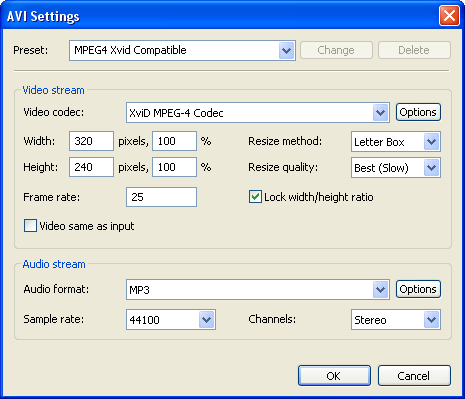|
|
|
| Movavi Slideshow Creator :: Format reference
:: AVI
|
AVI video format
AVI, a short for Audio Video Interleave, is a file format
designed to store both audio and video data in a standard package
to allow its simultaneous playback. Created by Microsoft in
November 1992, AVI is one of the most commonly used video
formats. A variation of the AVI format, called DV
AVI, is used to create Digital Video that can be transferred
losslessly (without loss of quality) between computers and
camcorders.
AVI is a file format, but unlike other formats like MP3
or JPEG, AVI is a container format, meaning it can contain
video audio compressed using many different combinations of codecs.
So while MP3 and JPG can only contain a certain kind of
compression, an AVI file can be compressed by all the
following codecs:

AVI all look the same on the "outside", but on the
"inside", they may be completely different.
So, the AVI format is dependent upon "codecs" (an
acronym for compressor / decompressor). Codecs serve two purposes:
they tell your computer how to encode (or compress) a video file
when you save the file, and they tell your computer how to decode
(or play) the file when you open the file. Since the same codec is
used for both compressing and playing the file, the choice of which
codec to use is extremely important. If the codec you use to
compress your file is not installed on your user's computer, your
user will not be able to play the video.
Settings
- Specify a video codec to compress your file with. The
drop-down menu shows the codecs correctly installed on your
computer. You can download more codecs at Movavi website. For
some codecs, you can specify its options (such as compression
quality, bitrate mode and others) by clicking Options. If
you choose Full Uncompressed, no codec will be used. This
option provides best quality but largest file size. Select
Recompress to save your file using selected codec and
discard the orignial compression.
- If needed, enter new values for Width and Height
of your video. The dimensions are in pixels. Check Link of width
and weight to constrain the proportions. Chose Resize
method and Resize quality.
- If needed, enter a new value for Frame rate. Larger
values produce "softer" videos but require more system
resources.
- Specify settings for the audio stream. Choose Audio
format, sample rate and Channels (Mono or Stereo).
Best audio quality (in terms of file size/quality) can be achieved
by selecting MP3 320 Kbit, 44100 kHz, Stereo.

Back to the list of formats
© MOVAVI
|

